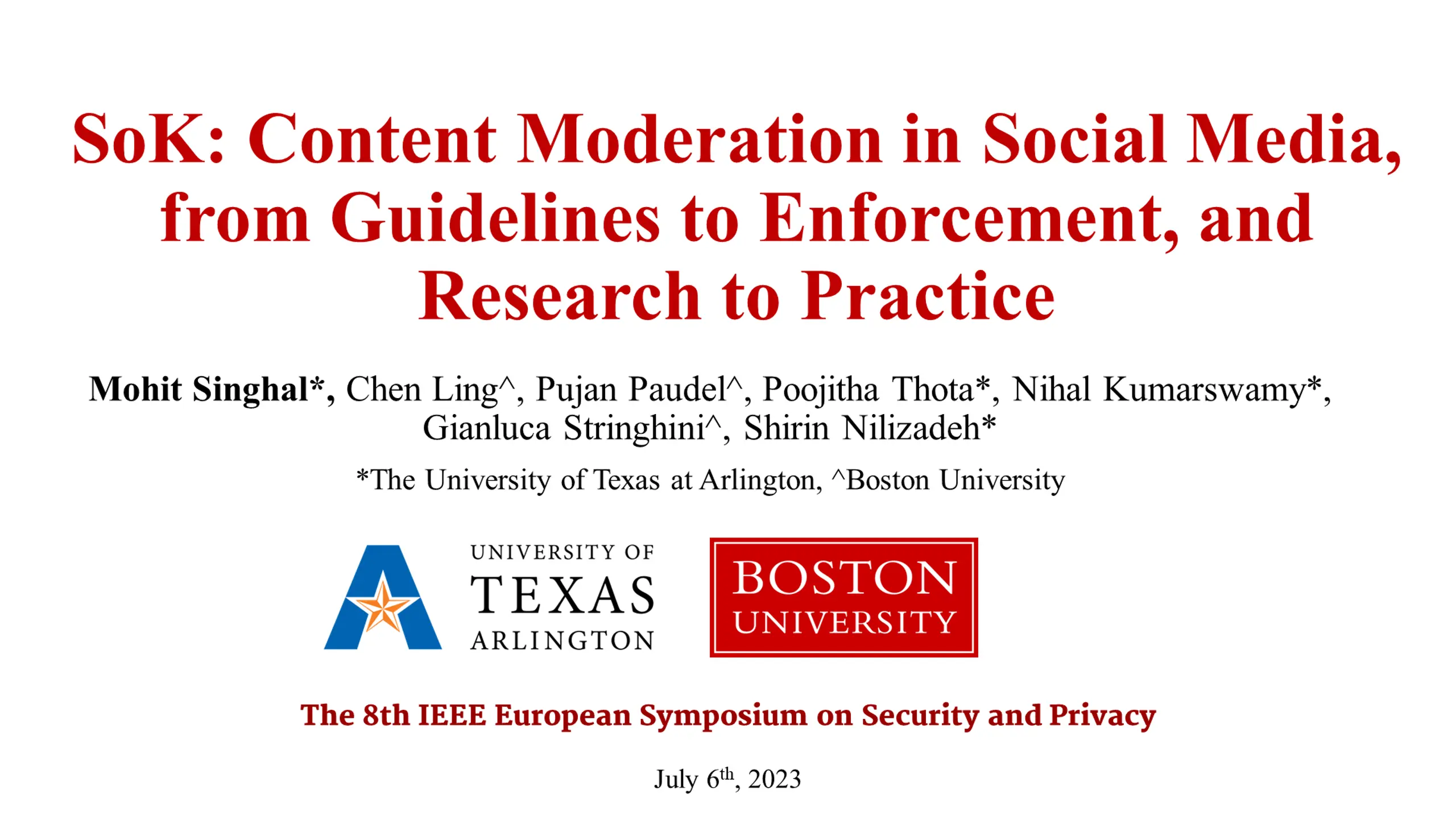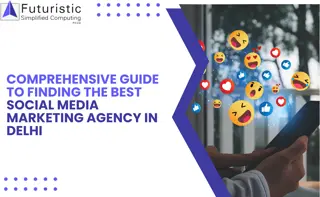Navigating Content Moderation Challenges in Social Media
Explore the complexities of content moderation in social media platforms, uncovering varying approaches and key research insights. Dive deep into the evolving landscape with over 200 curated publications on modern enforcement practices and guidelines.
Download Presentation

Please find below an Image/Link to download the presentation.
The content on the website is provided AS IS for your information and personal use only. It may not be sold, licensed, or shared on other websites without obtaining consent from the author.If you encounter any issues during the download, it is possible that the publisher has removed the file from their server.
You are allowed to download the files provided on this website for personal or commercial use, subject to the condition that they are used lawfully. All files are the property of their respective owners.
The content on the website is provided AS IS for your information and personal use only. It may not be sold, licensed, or shared on other websites without obtaining consent from the author.
E N D
Presentation Transcript
SoK: Content Moderation in Social Media, from Guidelines to Enforcement, and Research to Practice Mohit Singhal*, Chen Ling^, Pujan Paudel^, Poojitha Thota*, Nihal Kumarswamy*, Gianluca Stringhini^, Shirin Nilizadeh* *The University of Texas at Arlington, ^Boston University The 8th IEEE European Symposium on Security and Privacy July 6th, 2023
Content moderation is not an easy task! It is controversial and often perceived as biased 2
Content moderation is not uniform across different platforms, even platforms that are similar! 3
Content moderation is not uniform across different platforms, even platforms that are similar! 4
Controversial topics have different definitions across platforms Misinformation 5
However, there are some grey areas where not all social media platforms agree in moderation of content Hate Speech 6
Content moderation is not a one step process, it has multiple interlinked processes 7
We study and categorize the topics covered in content moderation research. We also investigated the current state of content moderation on several social media platforms. 8
Collated 200 plus publications about the ever- changing landscape of content moderation Examined the last five years of conference, workshops, and journal papers on content moderation IEEE S&P, USENIX Security, NDSS, ACM CCS, Euro S&P, CSCW, ICWSM, KDD, WSDM, ACL Anthology, CHI, WWW, New Media & Society, Political Behaviour, Social Media + Society, IEEE Transactions. Used related papers as a seed set and using snowballing method manually searched through related works. 9
Using the open coding process, three authors categorized all the papers Discuss Read papers to identify themes and sub-themes Discuss the themes of the papers disagreements to finalize the categories 10
Hate speech detection algorithms Content Based (4) [101], [102], [255], [258] Location Based (10) [72], [87], [115], [126], [205], [263], [297], [307], [310], [321] [58] [61], [65], [70], [71], [82], [88], [95], [106], [110], [114], [123], [124], [127], [132], [137], [146], [160], [175], [177], [192], [197], [206], [217], [220], [221], [229], [233], [237], [242], [245], [247], [253], [256], [292], [305], [308], [317], [322], [328], [336], [337], [340] Deep Neural Based (45) Hybrid [63], [94], [103], [128], [208], [235], [259] Approaches (7) Multi-modal Based (8) [137], [179], [194], [239], [285], [309], [311], [325] 11
Identified research gap for hate speech detection Designing richer, robust datasets. Conflating class labels in hate speech datasets. Varying definitions of hate speech across manual annotations. Benchmark datasets should be constructed. Lack of dialects specific datasets. Increasing need for cross-linguistic hate speech detection systems. Need for generalizable multi-modal hate speech detection model. 12
Misinformation detection algorithms Content Based (11) Propagation Based (8) Hybrid Approaches (5) Crowd Intelligence (7) Deep Neural Based (18) Knowledge Based (8) Multi-modal Based (7) [104], [119], [150], [154], [156], [238], [243], [287], [313], [314], [338] [195], [216], [262], [281], [282], [284], [287], [318] [153], [170], [176], [254], [283] [171], [181], [202], [241], [280], [301], [312] [64], [76], [100], [174], [196], [198], [202], [211], [219], [246], [254], [280], [291], [315], [318], [324], [329], [341] [100], [112], [157], [185], [211], [231], [291], [324] [178], [240], [274], [288], [290], [315], [320] 13
Identified research gap for misinformation detection Need for building comprehensive evaluation systems. Misinformation are not limited to elections or COVID-19, it can also be related to other topics. These are understudied. Focus on detecting domain-independent multi-modal misinformation. 14
Studies on moderation policies Consumption of news (12) Moderation Policies Engagement of users (21) Soft moderation interventions (23) Effectiveness (52) Hard moderation interventions (29) Support (13) Removal Comprehension (13) Fairness and Bias (26) 15
Identified research gap for moderation policies Diverse participants with specific demographic, such as age, gender etc., are needed for studies. More observatory studies for investigating statements in images, memes, and videos are needed. Data-driven studies focusing on specific groups of users with different cultures and backgrounds can help understand the factors that affect user engagement. Studies on popular platforms such as Facebook, and Instagram can help understand the impact of deplatforming. 16
Identified research gap for moderation policies Scholarships should investigate if labeling every news article can decrease the implied truth effect. Understanding if there is an echo chamber effect on users, when they are given the option to toggle off content with soft moderated label. Future scholarships should have participants from fringe websites, to understand what kind of regulations would be most interesting to them. Investigate novel and effective designs for a redressal system. Scholarship should further investigate approaches for improving the precision and recall, as well as the algorithmic fairness of abuse detection systems. 17
We investigated the terms of service and/or community guidelines Lays down the rules that users must abide when posting content on social media or when using social media. 18
We analyzed 14 social media platforms community guidelines and terms of service We chose platforms from both sides, i.e., mainstream and fringe platforms that are popular in the US. We focused on platforms that were investigated by prior research studies as well as those from recent political events, i.e., January 6thinsurrection. 19
We compared social media platforms in 5 countries and found no differences in the community guidelines and/or terms of service 20
Granularity can help users to understand in more detail the content that is allowed and what content is not allowed 21
Audio and visual context aid users to grasp the content that will be moderated 22
2 authors manually labelled the categories Resolve Yes, and Partial was labelled as 1 and No was labelled as 0 Read each platforms guidelines disagreements and calculate the final sum of each platforms 23
Mainstream social media are more granular and provide more examples than fringe platforms 24
Let us now discuss some common and high- level research gaps and challenges 25
Legal perspectives regarding content moderation In the US, balance between 1stAmendment and Section 230. In India and Germany, social media platforms are by law required to publish reports about handling of complaints and what action was taken. In Australia, users can submit complaints to Australian eSafety Commissioner 26
Transparency in moderation is necessary We echo for transparency reports as well as open APIs to conduct fairness assessment. Platforms should also publish the number of orders received from government agencies to remove content or suspend accounts, and whether the platform acted or not. 27
One size does not fit all in the amorphous nature of social media platforms All users should be treated equally, & their voices should not be suppressed. Platforms should publish policies that govern public figures and heads of states. 28
Need for a collaborative Human-AI decision making There is a need for more proactive human interventions to offset the errors done by ML based moderation. We echo for an oversight board that can make amends to decisions made by automated systems. For e.g., Facebook Oversight Board. It is crucial to develop fully or partially automated methods and algorithms that minimize the impact of bias on moderation decisions. 29
Conclusion We investigated the community guidelines and moderation practices of fourteen social media platforms. We studied and analyzed fourteen most popular social media content moderation guidelines and practices and consolidated them. We identified the differences between the content moderation employed in mainstream and fringe social media platforms. We identified the research gaps, differences in moderation techniques, and challenges that should be tackled by the social media platforms and the research community. 30
Thank You! mohit.singhal@mavs.uta.edu mohitinla Time Specific Snapshots of Platforms Policies Paper 31























